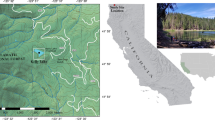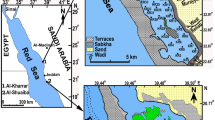Abstract
Diatom assemblages from the topmost sediment of 49 lakes were ordinated by means of a program for detrended correspondence analysis and reciprocal averaging (Decorana). Five lake groups were separated, each having more or less characteristic diatom assemblages and water quality. Shifts from one group to another caused by factors such as acidification, artificial drainage, diffuse nutrient loading and sewage are discussed.
Similar content being viewed by others
References
Alhonen, P., 1983. Aspects of the developmental history and paleolimnology of lakes in Finland. Devel. Hydrobiol., this volume.
Battarbee, R. W., 1979. Diatoms in lake sediments. In: Berglund, B. E. (Ed.). Paleohydrological changes in the temperate zone in the last 15 000 years. Subproject B, Vol. II, pp.177–225.
Charles, D. F., 1982. Studies of Adirondack Mountain (N.Y.) lakes: Limnological characteristics and sediment diatomwater chemistry relationships. Doctoral Dissertation, Indiana Univ. Bloomington.
Cholnoky, B. J., 1968. Die Ökologie der Diatomeen in Binnenge\:wassern. Weinheim. 669 pp.
Cleve, P. T., 1891. The Diatoms of Finland. Acta Soc. Fauna Flora Fenn. 8(2): 1–68 + 3 pl.
Foged, N., 1958. The diatom in the basalt area and adjoining areas of archean rock in West Greenland. Meddel. Grønland 156(4): 1–146.
]Hill, M. O., 1979. Decorana. A Fortran program for detrended corespondence analysis and reciprocal averaging. Ecology and Systematics. Cornell Univ. Ithaca.
Hill, M. O. & Gauch, M. G., 1980. Detrended correspondence analysis: an improved ordination technique. Vegetatio 42: 47–58.
Hustedt, F., 1937–39. Systematische und ökologische Untersuchungen über die Diatomeen-Flora von Java, Bali und Sumatra nach dem Material der Deutschen limnologischen Sunda-Expedition. I. Arch. Hydrobiol. Suppl. 15: 131–177, 187–295, 393–506, 638–790 + 28 pl.; Suppl. 16: 1–155, 274–394.
Hustedt, F., 1957. Die Diatomeenflora des Flusssystems der Weser im Gebiet der Hansestadt Bremen. Denkschrift über den heutigen ökologischen Zustand der Wasserstrassen im bremischen Staatsgebiet auf Grund der Kieselalgen Flora mit Beziehung auf die Abwasserverhältnisse. Abh. Naturwiss. Ver. Bremen 34: 181–440.
Järnefelt, H., 1956. Zur Limnologie einiger Gewässer Finnlands. XVI. Mit besonderer Berücksichtigung des Planktons. Ann. Zool. soc. ‘Vanamo’ 17: 1–201.
Jörgensen, E. G., 1948. Diatom communities in some Danish lakes and ponds. Kong. Dansk. Videnska. selsk. biol. skr. 5(2): 1–140.
Kolbe, R. W., 1932. Grundlinien einer allgemeinen Ökologie der Diatomeen. Ergebn. d. Biol. 8: 221–348.
Meriläinen, J., 1967. The diatom flora and the hydrogen ion concentration of the water. Ann. hot. fern. 4: 51–58.
Meriläinen, J., 1971. The recent sedimentation of diatom frustules in four meromictic lakes. Ann. hot. fern. 8: 160–176.
Meriläinen, J., Huttunen, P. & Pirttiala, K., 1981. Research strategy for the ecology of diatoms. The diatom study of the 151 lakes, in the eastern Finland. In: Ross, R. (Ed.). Proceedings of the sixth Symposium on Recent and Fossil diatoms. pp. 413–423. Otto Koetltz. Koenigstein.
Meriläinen, J., Huttunen, P. & Pirttiala, K., 1982. The effect of land-use on the diatom communities in lakes. Hydrobiol. 86: 99–103.
Mölder, K., 1946. Die geographische Verbreitung der Algen in Estland nebst einem Verzeichnis der Konjugaten. Ann. bot. soc. ‘Vanamo’ 21(6): 1–34.
Mölder, K., 1964. Abhängigkeit der Diatomeen von Felsgrund in Mittelfinnland. Ann. hot. fern. 1: 104–109.
Norton, S. A., Davis, R. B. & Brakke, D. F., 1981. Responses of northern New England lakes to atmospheric inputs of acid and heavy metals. Completion report Project A-048-ME. Land and Water Resources Center. Univ. of Maine, Orono. 90 pp.
Nygaard, G., 1956. Ancient and recent flora of diatoms and Chrysophyceae in lake Gribsø. Folia Limn. Scand. 8: 32–94, 253–262 + 12 pls.
Round, F. E., 1957. The distribution of Bacillariophyceae on some littoral sediments on the English Lake district. Oikos 8: 16–37.
Author information
Authors and Affiliations
Rights and permissions
About this article
Cite this article
Huttunen, P., Meriläinen, J. Interpretation of lake quality from contemporary diatom assemblages. Hydrobiologia 103, 91–97 (1983). https://doi.org/10.1007/BF00028434
Issue Date:
DOI: https://doi.org/10.1007/BF00028434




